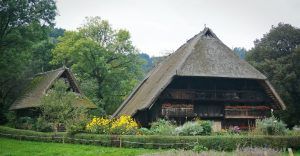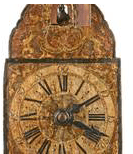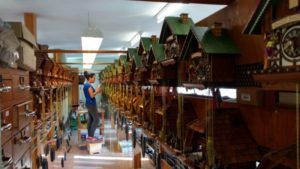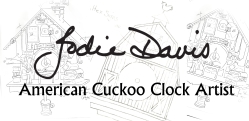History of Cuckoo Clocks

The Black Forest Wooden Clock Cottage Industry
The first Black Forest wooden clocks appeared in about 1650. Along with straw weaving and a few other handwork trades, wooden clock making became a cottage industry in the Black Forest in the 18th century. These clocks were of the lovely painted shield variety. Clockmaking workshops in farmhouses kept otherwise idle farmers productive during the winter months, and contributed to what was for many a life of subsistence.
However it was invented and by whomever, the cuckoo clock sang it's first tune in about 1738. I can only imagine how the new type of clock caught on with clockmakers as something novel, and the potential tune of cha-ching sent the farmers to their workshops to make cuckoos coo coo.

By about 1720 the scale of manufacturing grew to become significant. Still, working solo, a clockmaker's production was limited.
By the latter part of the century the division of labor, which we see to this day, had increased the clockmaker's production significantly. This specialization includes such independent craftsmen as bellows makers, case makers, and movement makers. Even the chains for the weights are made in the Black Forest!
In addition to the benefits of sepcialization, simplified standard designs allowed the clockmakers to sell their cuckoo clocks at comparatively low prices.
An estimated 100,000 clocks were manufactured in the Black Forest in 1800. (I am working on further insight into the size of the industry over time.)
Marketing Cuckoo Clocks
From the second half of the 18th century clock peddlers, known as clock carriers, traveled throughout Europe and even overseas to sell Black Forest cuckoo clocks. Many of these were of the painted shield variety, bearing the trader's name and place of sale on the lacquer shield.

Cuckoo Clock Making Today
A handful of companies of skilled cuckoo clock makers remain in the Black Forest today. Today companies including Schneider, Hones, Herr, and Schwer and several others carry on the skilled trade of creating Germany's icon, the cuckoo clock.
Cuckoo Clock History Resources
The German Clock Museum / Deutches Uhrenmuseum
Much of this information I learned during my visit to The German Clock Museum. I strongly suggest allotting an hour's time in the museum when in the Black Forest. Located in Furtenwagon, the museum is a lovely drive over a few mountains and down into a valley.
Black Forest Clockmaker and the Cuckoo Clock by Karl Kochmann
First published in 1978, this must-have book for cuckoo lovers was last updated and reprinted in 1996. It is truly an encyclopedia of everything cuckoo clock including catalog pages, company histories, cuckoo clock history and development of the cuckoo clock, schematics, repair, etc. Out of print now, you'll have to watch Amazon and eBay for it, but it's worth the hunt!
